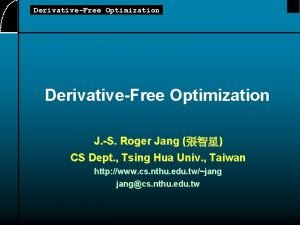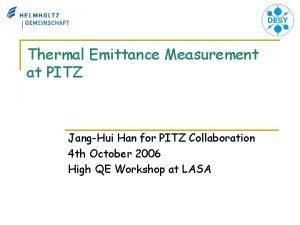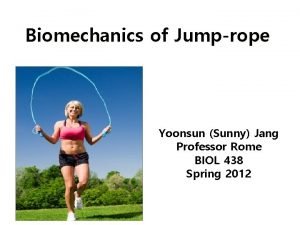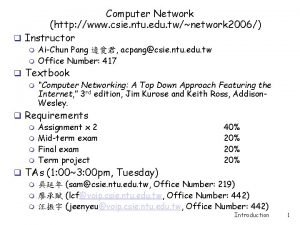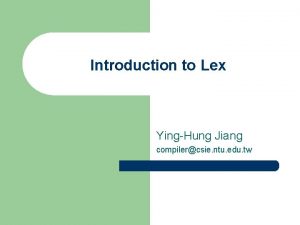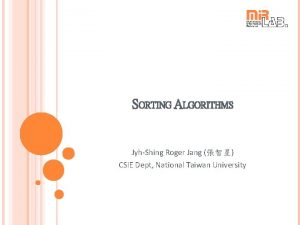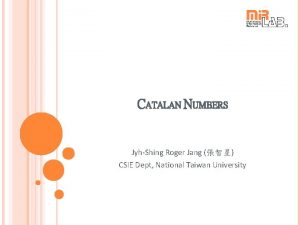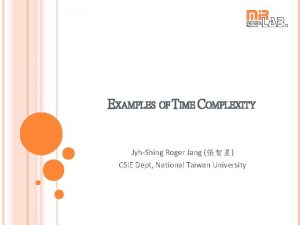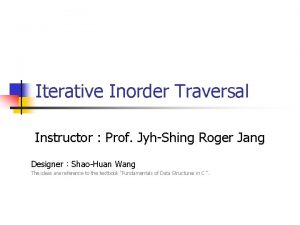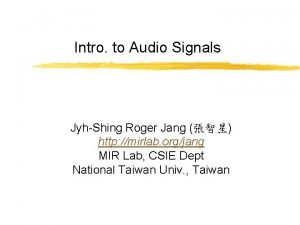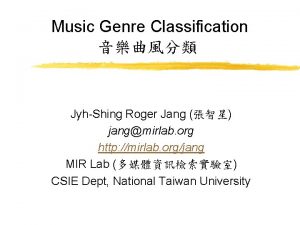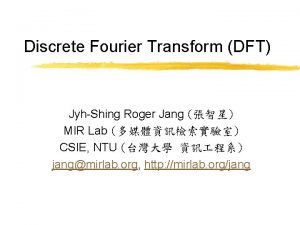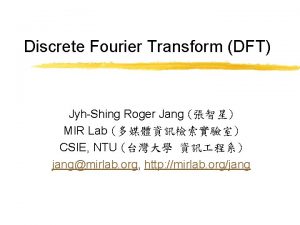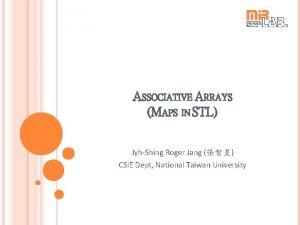ANALYSIS TOOLS JyhShing Roger Jang CSIE Dept National
































- Slides: 32

ANALYSIS TOOLS Jyh-Shing Roger Jang (張智星) CSIE Dept, National Taiwan University

SEVERAL BASIC FUNCTIONS Polynomial Constant function Linear function Quadratic function Cubic function Logarithm function N-Log-N function Exponential function Commonly used basic functions 1 < log(n) < n 1/2 < n log(n) < n 2 < n 3 < n 4 < … < 2 n < 3 n < 4 n < … < nn Others: log(n)), (log(n))2, etc. 2

FAMILY OF POLYNOMIALS Constant function f(n)=1 n: problem size Linear function f(n)=n Quadratic function f(n)=n 2 Cubic function f(n)=n 3 A general polynomials f(n)=a 0+a 1 n+a 2 n 2+a 3 n 3+…+adnd 3

THE LOGARITHM FUNCTION f(n)=log 2(n)=log(n) Definition of logarithm Some identities More… The default base is 2. The base is e=2. 71828…. 4

THE N-LOG-N FUNCTION f(n)=n*log (n) 5

THE EXPONENTIAL FUNCTION f(n)=an Some identities (for positive a, b, and c) a(b+c) = aba c abc = (ab)c ab /ac = a(b-c) b = a logab bc = a c*logab 6

GROWTH RATE COMPARISONS Log-log chart 7

RUNNING TIME Most algorithms transform input objects into output objects. The running time of an algorithm typically grows with the input size. Average case time is often difficult to determine. We focus on the worst case running time. Sorting, for example Easier to analyze Crucial to applications such as games, finance and robotics 8

PERFORMANCE MEASUREMENT VIA EXPERIMENTS Write a program implementing the algorithm Run the program with inputs of varying size and composition Use a function like clock() to get an accurate measure of the actual running time Plot the results 9

LIMITATIONS OF EXPERIMENTAL STUDIES It is necessary to implement the algorithm, which may be difficult Results may not be indicative of the running time on other inputs not included in the experiment. In order to compare two algorithms, the same hardware and software environments must be used 10

THEORETICAL PERFORMANCE ANALYSIS Uses a high-level description of the algorithm instead of an implementation Characterizes running time as a function of the input size, n. Takes into account all possible inputs Allows us to evaluate the speed of an algorithm independent of the hardware/software environment 11

ABOUT PRIMITIVE OPERATIONS Primitive operations Basic computations performed by an algorithm Identifiable in pseudocode Largely independent from the programming language Exact definition not important (we will see why later) Assumed to take a constant amount of time Examples: Evaluating an expression Assigning a value to a variable Indexing into an array Calling a method Returning from a method 12

COUNTING PRIMITIVE OPERATIONS By inspecting the pseudocode, we can determine the maximum number of primitive operations executed by an algorithm, as a function of the input size Algorithm array. Max(A, n) current. Max A[0] for i 1 to n 1 do if A[i] current. Max then current. Max A[i] { increment counter i } return current. Max # operations 2 2 n 2(n 1) 1 Total 8 n 2 13

ESTIMATING RUNNING TIME Algorithm array. Max executes 8 n 2 primitive operations in the worst case. Define: a = Time taken by the fastest primitive operation b = Time taken by the slowest primitive operation Let T(n) be worst-case time of array. Max. Then a (8 n 2) T(n) b(8 n 2) Hence, the running time T(n) is bounded by two linear functions Change the hardware environment only affects a and b. The linear growth rate of the running time T(n) is an intrinsic property of algorithm array. Max 14

BIG-OH NOTATION Given functions f(n) and g(n), we say that f(n) is O(g(n)) if there are positive constants c and n 0 such that f(n) cg(n) for n n 0 Example: 2 n + 10 is O(n) g(n): basic functions Quiz! 2 n + 10 cn (c 2) n 10/(c 2) Pick c = 3 and n 0 = 10 Log scale 15

BIG-OH EXAMPLE Example: the function n 2 is not O(n) cn n c The above inequality cannot be satisfied since c must be a constant n 2 16

MORE BIG-OH EXAMPLES 7 n-2 is O(n) Need c > 0 and n 0 1 such that 7 n-2 c • n for n n 0 This is true for c = 7 and n 0 = 1 3 n 3 + 20 n 2 + 5 is O(n 3) Need c > 0 and n 0 1 such that 3 n 3 + 20 n 2 + 5 c • n 3 for n n 0 This is true for c = 28 and n 0 = 1 3 log n + 5 is O(log n) Need c > 0 and n 0 1 such that 3 log n + 5 c • log n for n n 0 Quiz! This is true for c = 8 and n 0 = 2 17

BIG-OH RULES If is f(n) a polynomial of degree d, then f(n) is O(nd), i. e. , Drop lower-order terms 2. Drop constant factors 1. Use the smallest possible class of functions Say “ 2 n is O(n)” Use instead of “ 2 n is O(n 2)” the simplest expression of the class Say “ 3 n + 5 is O(n)” instead of “ 3 n + 5 is O(3 n)” 18

ASYMPTOTIC ALGORITHM ANALYSIS The asymptotic analysis of an algorithm determines the running time in big-Oh notation That is, when n is big! To perform the asymptotic analysis We find the worst-case number of primitive operations executed as a function of the input size We express this function with big-Oh notation Example: We determine that algorithm array. Max executes at most 8 n 2 primitive operations We say that algorithm array. Max “runs in O(n) time” Since constant factors and lower-order terms are eventually dropped anyhow, we can disregard them when counting primitive operations 19

COMPUTING PREFIX AVERAGES We further illustrate asymptotic analysis with two algorithms for prefix averages The i-th prefix average of an array X is average of the first (i + 1) elements of X: A[i] = (X[0] + X[1] + … + X[i])/(i+1) Computing the array A of prefix averages of another array X has applications to financial analysis 20

PREFIX AVERAGES (QUADRATIC) The following algorithm computes prefix averages in quadratic time by applying the definition directly. Algorithm prefix. Averages 1(X, n) Input array X of n integers Output array A of prefix averages of X #operations A new array of n integers n for i 0 to n 1 do n s X[0] n for j 1 to i do 1 + 2 + …+ (n 1) s s + X[j] 1 + 2 + …+ (n 1) A[i] s / (i + 1) n return A 1 21

PREFIX AVERAGES (LINEAR) The following algorithm computes prefix averages in linear time by keeping a running sum Algorithm prefix. Averages 2(X, n) Input array X of n integers Output array A of prefix averages of X A new array of n integers s 0 for i 0 to n 1 do s s + X[i] A[i] s / (i + 1) return A #operations n 1 n n n 1 22

COMPARISON OF TWO ALGORITHMS Two sorting algorithms Merge sort is O(n log n) Insertion sort is O(n 2 ) To sort 1 M items Insertion sort 70 hours Merge sort 40 seconds For a faster machine Insertion sort 40 minutes Merge sort 0. 5 seconds Slide by Matt Stallmann 23

RELATIVES OF BIG-OH Big-Omega f(n) is (g(n)) if there is a constant c > 0 and an integer constant n 0 1 such that f(n) c • g(n) for n n 0 Big-Theta f(n) is (g(n)) if there are constants c’ > 0 and c’’ > 0 and an integer constant n 0 1 such that c’ • g(n) f(n) c’’ • g(n) for n n 0 24

INTUITION FOR ASYMPTOTIC NOTATION Big-Oh: upper bound f(n) is O(g(n)) if f(n) is asymptotically less than or equal to g(n) Big-Omega: lower bound f(n) is (g(n)) if f(n) is asymptotically greater than or equal to g(n) Big-Theta: average bound f(n) is (g(n)) if f(n) is asymptotically equal to g(n) 25

EXAMPLE USES OF THE RELATIVES OF BIG-OH 5 n 2 is (n 2) f(n) is (g(n)) if there is a constant c > 0 and an integer constant n 0 1 such that f(n) c • g(n) for n n 0 let c = 5 and n 0 = 1 5 n 2 is O(n 2) f(n) is (g(n)) if there is a constant c > 0 and an integer constant n 0 1 such that f(n) < c • g(n) for n n 0 let c = 5 and n 0 = 1 5 n 2 is (n 2) f(n) is (g(n)) if it is (n 2) and O(n 2). 1 < log(n) < n 1/2 < n log(n) < n 2 < n 3 < n 4 < … < 2 n < 3 n < 4 n < … < nn (n 2) O(n 2) 26

COMPUTING POWERS To compute the power function p(x, n) = xn Method 1 n, n-1, n-2, …, 2, 1 O(n) Method 2 n, n/2, n/4, … , 2, 1 O(log n) 27

ELEMENT UNIQUENESS PROBLEM (1/2) To determine if the elements in a vector are all unique O(2 n) implementation by recursion O(n 2) implementation by looping 28

ELEMENT UNIQUENESS PROBLEM (2/2) To determine if the elements in a vector are all unique O(n log n) implementation Sort the vector first and check for neighboring duplicate elements A faster average-case running time can be achieved by using the hash table data structure (Section 9. 2). 29

HOW TO PROVE STATEMENTS By giving counter example Roger claims that every number of the form 2 i-1 is a prime, where i is an integer greater than 1. Prove he is wrong. By contrapositive: Switching the hypothesis and conclusion of a conditional statement and negating both. If p is true, then q is true If q is not true, then p is not true If a*b is even, then a is even or b is even. If a is odd and b is odd, then a*b is odd. Be aware of “De. Morgan’s Law” By math induction Example: Prove that F(n)<2 n, where F(n) is the Fibonacci function with F(n+2)=F(n+1)+F(n), and F(1)=1, F(2)=2. 30

EXERCISE ON BIG OH Given functions f(n) and g(n), under what condition do we we say that f(n) is O(g(n))? Note that g(n) is one of the basic functions, such as n 3. What is the physical meaning of the definition? Use the definition of big oh to explain why 3 n 2+nlog(n)+2 n+5 log(n) is O(n 2). 31

EXERCISE ON PROOF BY INDUCTION Proof by induction Prove that F(n)<2 n, where F(n) is the Fibonacci function satisfying F(n+2)=F(n+1)+F(n), with F(1)=1, F(2)=2. 3 steps in proof by induction Base case Inductive Hypothesis Inductive Step 32
 Roger jang
Roger jang Jang multimedia
Jang multimedia Jang hayoung
Jang hayoung Jinho jang
Jinho jang Berkay bahadur
Berkay bahadur Jang
Jang Jang
Jang Jang
Jang Yeongjin jang
Yeongjin jang Dr helen jang
Dr helen jang Jumping jang
Jumping jang Yeongjin jang
Yeongjin jang Ntu vpn
Ntu vpn Cgu csie
Cgu csie Ntu csie
Ntu csie Csie.nctu.edu.tw login
Csie.nctu.edu.tw login Ccu csie
Ccu csie Csie.nctu.edu.tw login
Csie.nctu.edu.tw login Ncue csie
Ncue csie Csie workstation
Csie workstation Csie.nctu.edu.tw webmail
Csie.nctu.edu.tw webmail Ncnu csie
Ncnu csie Csie.ntu
Csie.ntu Poker bet challenge
Poker bet challenge Bill fenner
Bill fenner Ntu csie
Ntu csie Dept nmr spectroscopy
Dept nmr spectroscopy Florida department of agriculture and consumer services
Florida department of agriculture and consumer services Finance departments
Finance departments Worcester building dept
Worcester building dept Dept. name of organization
Dept. name of organization Mn dept of education
Mn dept of education Liz welch mississippi
Liz welch mississippi
